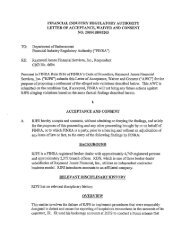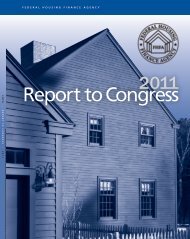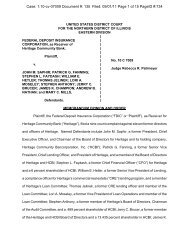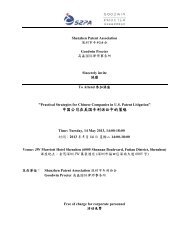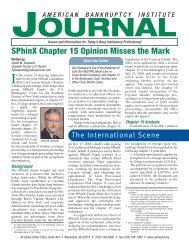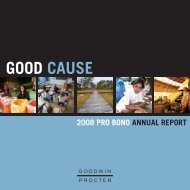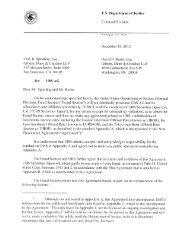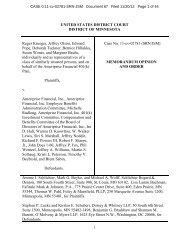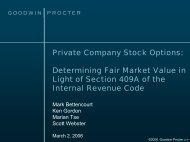FDIC as Receiver for City Bank vs. Conrad D. Hanson and ...
FDIC as Receiver for City Bank vs. Conrad D. Hanson and ...
FDIC as Receiver for City Bank vs. Conrad D. Hanson and ...
Create successful ePaper yourself
Turn your PDF publications into a flip-book with our unique Google optimized e-Paper software.
C<strong>as</strong>e 2:13-cv-00671 Document 1 Filed 04/15/13 Page 32 of 97<br />
1<br />
2<br />
3<br />
4<br />
5<br />
6<br />
7<br />
8<br />
9<br />
10<br />
11<br />
12<br />
13<br />
14<br />
15<br />
16<br />
17<br />
18<br />
19<br />
20<br />
21<br />
22<br />
23<br />
24<br />
25<br />
26<br />
27<br />
Policy stressed the importance of liquidity in the composition of net worth.<br />
The Loan Memo showed that <strong>City</strong> <strong>Bank</strong>'s loan commitments to Borrower<br />
B, including the Borrower B (II) Loan, plus Guarantor B's personal<br />
liabilities totaled $17,830,400. The Loan Memo listed two different c<strong>as</strong>h<br />
amounts <strong>for</strong> Guarantor B—$724,388 <strong>and</strong> $155,842. Even if Guarantor B<br />
had a c<strong>as</strong>h balance of $724,388, that amount plus Borrower B's c<strong>as</strong>h w<strong>as</strong><br />
only 6.5 percent of the guarantor's liabilities plus <strong>City</strong> <strong>Bank</strong>'s total loan<br />
commitments to Borrower B. When Defendants approved the Borrower B<br />
(II) Loan, the Real Estate Bubble had burst, <strong>and</strong> the guarantor had<br />
insufficient liquid <strong>as</strong>sets to repay the Borrower B (II) Loan.<br />
d. Failed to consider or knew of <strong>and</strong> disregarded the LTV ratio limit<br />
violation of the Borrower B (II) Loan. The <strong>Bank</strong>'s January 9, 2008 Loan<br />
Policy provided that, <strong>for</strong> purposes of the LTV ratio, "Value shall be<br />
defined <strong>as</strong> the lesser of appraised value or purch<strong>as</strong>e price (cost)." The<br />
Loan Policy further provided that the LTV ratio limit <strong>for</strong> SFR construction<br />
loans w<strong>as</strong> 80 percent, which w<strong>as</strong> less than the supervisory LTV ratio limit<br />
<strong>for</strong> single-family residential construction loans of 85 percent. Given the<br />
loan amount of $5,928,800 <strong>and</strong> the estimated aggregate cost of the<br />
construction project of $5,583,421, the LTV ratio of the Borrower B (II)<br />
Loan w<strong>as</strong> 106.2 percent. This LTV ratio violated the Loan Policy's limit<br />
<strong>and</strong> the supervisory limit.<br />
94. In or about March 2009, Borrower B defaulted on the loan.<br />
95. <strong>Hanson</strong>'s <strong>and</strong> Sheehan's acts <strong>and</strong> omissions with respect to the Borrower B (II)<br />
Loan caused <strong>City</strong> <strong>Bank</strong> to incur damages in an amount to be proved at trial. When <strong>Hanson</strong> <strong>and</strong><br />
Sheehan approved this loan, the <strong>Bank</strong> had initiated <strong>for</strong>eclosure proceedings against at le<strong>as</strong>t three<br />
construction loan borrowers, <strong>and</strong> the Real Estate Bubble had burst about 20 months earlier.<br />
Because of these negative indicators <strong>and</strong> because repayment of the Borrower B (II) Loan<br />
COMPLAINT - Page 32<br />
ATER WYNNE LLP<br />
1652284/1/SKB/105030-0018 601 UNION STREET, SUITE 1501<br />
SEATTLE, WA 98101-3981<br />
(206) 623-4711



